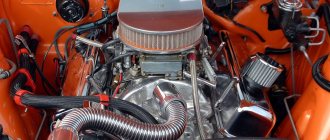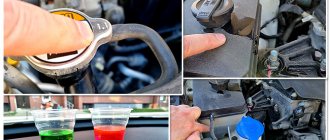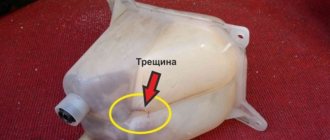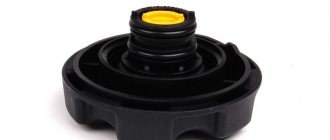When such an unpleasant situation as a coolant leak occurs, many owners of VAZ-2114 cars complain about this nuisance due to the great age of the car. However, of course, every car owner, when purchasing a car, inspected it and checked all components and parts for breakdowns, and would hardly have purchased such a car with leaks in the engine cooling system.
The video describes the process of finding the cause of an antifreeze leak on a VAZ car:
Scheme of the functioning of the cooling system.
Cars of the Samara-2 family (VAZ 2113, 2114, 2115) are equipped with a closed-type cooling system with forced circulation of coolant. The system maintains excess antifreeze pressure, which creates an increased boiling point and allows the liquid to heat up to 110-115°C.
1 – expansion tank plug; 2 – extended
at temperatures below 85°C, antifreeze flows in a small circle, ensuring quick warm-up of the engine, and when the value reaches 85 degrees, the thermostat opens a large circle, and hot antifreeze enters the radiator. When the car moves, the antifreeze in the radiator is cooled by blowing with a flow of oncoming air and then returns through the pipes to the engine block.
The antifreeze temperature is monitored by a sensor in the thermostat housing, information from which goes to the instrument panel indicator and to the car's ECU. When the antifreeze heats up to a certain temperature (95°, 98°, 105° - depending on the settings of the control unit), the electric motor of the fan located on the inside of the radiator automatically turns on. Also, on front-wheel drive VAZs, antifreeze from the engine transfers heat to the heater radiator to heat the interior.
An expansion tank with an antifreeze level sensor is used to fill the system with liquid. The total capacity of the VAZ 2114 system depends on the modification and averages 7.8 liters.
conclusions
However, in any case, even if the cooling system tank is partially malfunctioning, it is better not to waste a couple of hundred and buy a new tank, having previously chosen a known quality one. Good roads to everyone and stable temperatures!
I decided to write a separate entry about this since many people have such symptoms, but I couldn’t find the reason for a very long time, since on the forums, incl. on Drive everyone wrote that my head was “broken”, “there is air in the system”, “bad cap”, etc. But in the end the reason turned out to be completely different! Description of the problem: I pour antifreeze to the level (just below the MAX mark) and start the engine. As long as the engine is cold everything is fine. That is, you can gas as much as you like and nothing spills out or happens (that’s why I dismissed the option of a broken head or gasket right away). But as soon as the temperature rises to 90-95 degrees (including at idle), the antifreeze level begins to rise sharply and, as a result, the tank overflows and the liquid flows out before the fan turns on. As soon as the fan turns on, after 2 seconds everything returns to normal, but everything has already poured out of the tank and it remains empty. I thought that the antifreeze was cheap and bad and boiled ahead of time (expanded and overflowed), I bought more expensive antifreeze, drained the old one, poured in a new one, but nothing changed.
I connected the laptop and saw that the antifreeze began to overflow the tank at a temperature of 93 degrees, that is, the indicators coincided with the instrument panel readings. And this is a temperature at which even water in the system would not boil! Since two temperature sensors showed that antifreeze was pouring out at a temperature of 93-95 degrees, at first I had no doubt about the correctness of their readings. BUT, when I removed the temperature sensor that goes to the ECU, I saw this:
Prevention of squeezing out antifreeze from the expansion tank
The reasons, of course, can be very different, but the most common is wear of parts of the car’s cooling system. High temperatures constantly affect the elements of the system - tanks, pipes, hoses, sensors, and so on - which, naturally, leads to exhaustion of the working resource. One of the parts stops performing its function and the entire system begins to malfunction or stops functioning altogether.
- First of all, you should pay attention to whether the thermostat is working. If it is closed, then the antifreeze does not enter the radiator and cannot cool. Naturally, the antifreeze boils and begins to be knocked out of the expansion tank. It is easy to diagnose this malfunction - touch the radiator. If the engine temperature is more than one hundred degrees and you can see how the antifreeze in the expansion tank begins to boil, and the radiator is cold, the thermostat is faulty. If the radiator is hot, then most likely the temperature sensor or the cooling fan itself has failed.
- But there are also the opposite situations, when the car is new, but the antifreeze still leaks out of the expansion tank. This is most likely due to poor quality assembly or defective parts. Since in most modern cars the cooling system is sealed, there are enough burrs or burrs on the opening of the expansion tank that the seal of the cap is not tight and strong enough. The seal is broken, hence the release of antifreeze from the cooling system.
- It is not uncommon for holes to form in the expansion tank itself. If the plastic material of the tank is made poorly, it may not withstand high temperatures.
Pump failure
- Boiling antifreeze can also cause a blowout. The process of antifreeze boiling itself is usually caused by engine overheating. Overheating of the engine can occur due to a broken thermostat or a malfunction in the cooling system. The cause may also be a breakdown of the water pump (water pump).
Thus, the main reason why antifreeze is knocked out of the expansion tank is a technical problem related to the car’s cooling system.
Having broken through the gaskets
- It also happens that exhaust gases get into the antifreeze, as a result, the pressure in the cooling system increases and the antifreeze begins to be squeezed out of the expansion tank. One of the worst scenarios for a breakdown, in which case the car owner will be forced to repair the engine.
First of all, the appearance of old, already used parts in the car’s cooling system should be eliminated. If there are defective parts, they should be replaced immediately. Don't skimp on cooling system parts. Such savings will lead to problems associated with the operation of the motor, which will ultimately cost much more.
It is not recommended to repair the radiator or water pump. As a rule, such repaired parts do not last long and, in the end, break completely. Therefore, if a radiator or water pump breaks down, it is better to replace it with a new one.
When crimping hoses, you need to pay attention to spring clamps, because such fixation of pipes, as practice shows, is the most reliable and durable.
If antifreeze is knocked out due to the presence of a hole or crack in the expansion tank, then the tank is not repaired, but replaced with a new one.
Didn't find the information you are looking for? on our
forum
.
If you find an error, please highlight a piece of text and press Ctrl Enter.
Cooling of the VAZ-2114 is carried out as follows:
- coolant from the tank enters the water circuit (“jacket”) of the engine;
- antifreeze circulates in the “jacket” in a small circle until it reaches 95° C along with the engine;
- the thermostatic valve opens and antifreeze is delivered to the radiator for cooling;
- excess liquid that is formed as a result of expansion during heating is returned to the expansion tank.
Thus, sources of antifreeze or antifreeze leakage can be:
- The expansion tank itself - under the influence of alcohol antifreeze, cracks may appear on it.
The easiest way to detect the cause of the leak is if antifreeze leaves the expansion tank of the VAZ 2114. In this situation, the liquid may end up under the driver's mat or the hood of the car.
Also, to understand exactly where the leak is located, you can put a sheet of cardboard or paper under the hood and start the engine for about half an hour. Drops on the sheet will indicate the location of the leak.
To find out exactly where the VAZ 2114 antifreeze goes, you need to conduct a thorough inspection of the cooling system:
- Hoses and pipes - usually cracks on them are visible immediately upon inspection. If coolant leaks at the joints, oily traces indicate a leak.
- Radiator – this is where the leak is harder to notice due to scale or dirt. Therefore, it is recommended to carry out a pressure test. The upper pipe from the radiator is disconnected, plugged, and pressure is built up with a compressor. If a leak appears, the radiator must be removed and welded.
- Thermostat (in the injection model, located under the air filter) - in this case, the valve “jamming” is observed, since it is subject to mechanical stress and high temperatures.
- Engine jacket - in this case, the engine begins to “trouble”, and a large amount of steam comes out of the exhaust pipe. At the same time, engine oil becomes gray in color and changes consistency.
- Expansion tank cap - to check this cause of the leak, you need to start the engine by removing the cap from the tank and holding down the accelerator. If the fluid level rises sharply, then there is a leak here.
- The cylinder head gasket is worn or loose. In places of leakage, coolant usually “bulges out”. Also in this case, antifreeze or antifreeze may get into the engine oil.
There is certainly a problem with age, but it is negligible, therefore, the reason will most likely lie elsewhere; below we will try to figure out why coolant leaks occur.
Traces of smudges are a reason to be wary
This happens because the coolant contains harmful substances that destroy the radiator honeycomb. In addition to these reasons, the cooling radiator is actively affected by external irritating factors, such as weather and high humidity, which can result in corrosion and destruction of the main parts of the radiator.
Let's consider less common situations.
Triggering of the safety valve - causes and consequences
As just said, the reason why antifreeze is thrown out of the expansion tank of a VAZ 2114 is most often a leak in the engine cooling system. It leads to air leaks into the line or, conversely, prevents normal coolant circulation and cooling. This, in turn, causes the liquid in the tank to boil and be squeezed out through the safety valve of its lid.
The main reasons for this may be:
- Factory defects in the tank.
- Microcracks in pipes.
- Blockages or cracks in the radiator.
- Water pump malfunction.
- Thermostat malfunction.
- Burnt out cylinder head gasket.
Inspection of the tank
You should start troubleshooting small, namely, by inspecting the tank, all hoses and pipes of the cooling system. If cracks or coolant leaks are noticed on them, they should be replaced.
On the tank, in addition to cracks, you should pay attention to the quality of the casting and the correct shape of the body. If inhomogeneities, sloppy mold marks (burst), strong bulges or dents are noticeable on it, then it is better to replace such an expansion tank with a new one (when choosing which in a store you should be guided by exactly the same rules).
Radiator
The next element of the system that will need to be checked is the radiator. It will need to be examined for leaks and cleaned of contaminants (external and internal, in the first case by blowing, in the second by washing).
Very often, it is the poor thermal conductivity of the radiator due to its severe contamination that causes incomplete cooling of the coolant and, as a result, its boiling inside the expansion tank.
Pump and thermostat
If the radiator also turns out to be in order, then you will need to check the condition of the pump (water pump) and thermostat (we talked about how to do this earlier). If during the inspection a fault is discovered in any of these parts, it will need to be replaced with a similar one.
In some cases, for example, on a long journey, you can try to “bring back to life” a jammed thermostat (driving superheated liquid only in a small circle) by knocking on its body. True, this measure is temporary and does not exclude its further replacement.
Cylinder head gasket
The last reason why antifreeze is thrown out of the expansion tank of a VAZ 2114 is the burnout of the cylinder head gasket. This malfunction is the most serious because, flowing out of the cooling jacket, the coolant instantly mixes with the engine oil, forming a stable emulsion. For obvious reasons, it sharply loses its lubricating abilities, leading to overheating of the moving parts of the motor and even to jamming.
A sure sign that coolant has leaked into the engine oil is thick white smoke coming out of the exhaust pipe.
Having discovered such a malfunction, you should not hesitate - you should immediately stop the trip and return to the garage (and if it happened on a long journey, then visit the nearest service station or call a tow truck, since major engine repairs can be much more expensive).
Having arrived home or at the workshop, you will need to dismantle the cylinder head and replace the paronite gasket (this can be done either independently or in a car service, but in any case, after completing the repair, it is recommended to carry out a full diagnosis of the condition of the engine).
Signs of a malfunction of the cooling system.
Most often, failure of the cooling system is associated with loss of tightness, which leads to coolant leakage. The symptoms of this problem are easy to spot:
- reducing the level of antifreeze in the expansion tank below the minimum,
- a sharp increase in the temperature indicator readings on the instrument panel,
- copious steam of boiling liquid from under the hood,
- antifreeze drips on the engine protection or under the front of the car when parked.
Cylinder block.
The liquid coolant circulates in the engine block through a system of special channels - the cooling jacket. If a malfunction occurs, antifreeze may leak for the following reasons:
- insufficient tightening of the cylinder head bolts,
- head gasket failure,
- formation of metal microcracks.
If, after a long period of parking on a cold engine, coolant leaks are noticeable at the junction of the head and block, then most likely the cylinder head bolts are not tightened properly. To eliminate a leak, check the tightness of the bolts and, if necessary, tighten them to the required torque.
If the cylinder head gasket is damaged, the antifreeze goes inside the engine: either into the combustion chamber or into the crankcase.
Coolant entering the combustion chamber causes unstable engine operation (up to the impossibility of starting) and thick milky-white smoke from the muffler. Antifreeze that gets into the combustion chamber washes away all the carbon deposits until they shine, which can be determined by turning out the spark plugs and shining a flashlight into the spark plug wells.
If the coolant goes into the engine crankcase, it mixes with the oil. This fact can be diagnosed by the presence of a white emulsion coating on the oil filler cap and on the oil dipstick. A sharp darkening of fresh antifreeze is another symptom that the cooling system is in contact with oil. It is necessary to replace a broken or burnt cylinder head gasket.
The worst option is the appearance of microcracks: the symptoms are similar to the previous case, but it is problematic to eliminate this problem with your own hands. First of all, the crack may not be visible on the removed part, but it will certainly manifest itself when the bolts are tightened and on a warm engine. To eliminate microcracks, the head or block is polished using specialized equipment. In the worst case scenario, you will need to purchase a new cylinder head.
Water pump.
The pump on the VAZ 2114 (catalog number 2109-1307010) is installed in the lower part of the engine block under the timing belt tension roller. If you detect coolant leaks on the protection in the area of the right front wheel, you should remove the plastic timing belt cover and check the pump. If coolant leaks are found on the pump housing or at the point where it connects to the engine block, it is necessary to remove the timing belt and replace the part. Also grounds for replacement are play in the pump pulley or jamming when the shaft rotates.
The water pump is attached to the block with three bolts. Often, due to exposure to high temperatures, the pump body “sticks” to the seat; in this case, in order to dismantle the pump, it should be carefully tapped. Before installing a new part, be sure to clean the contact area on the engine from remnants of the old gasket and sealant. Among car owners, water pumps from TZA (Tolyatti), LUZAR and a reliable, but more expensive option: HEPU are popular.
Thermostat.
The thermostat is located at the top of the engine block on the left side, and a coolant temperature sensor is also installed in the thermostat housing. Standardly, the VAZ 2114 is equipped with a non-separable thermostat (catalog number 2108-1306010), which is connected to the block by a rubber pipe with two clamps.
With this model, over time, coolant leaks are possible at the connections with the pipes due to loosening of the fixing clamps or cracking of the hoses. In this case, it is necessary to tighten the fasteners, and if cracks or breaks are detected, remove the failed hoses for subsequent replacement.
If the car had several owners, then perhaps the cooling system was modernized, in particular, a ten-point thermostat (21082-1306010) could be installed. This thermostat is attached directly to the engine with a bolt connection and is equipped with a removable cover with a thermoelement. With this modification, in addition to leaks in the pipes, there is a possibility of antifreeze leaking from under the cover gasket. Repair consists of unscrewing three hex screws to remove the top cover and replace the gasket.
In addition to coolant leaks in the thermostat, the thermoelement may fail. This results in antifreeze not entering the radiator. Signs of this malfunction: the engine heats up quickly, the fan often works, and in a car heated to 90 degrees, the lower radiator outlet hose remains cold. In such a situation, it is necessary to replace the thermostat.
Products from the following manufacturers are popular among VAZ owners: LUZAR, WEEN, and PRAMO, but reviews of the latter are quite contradictory.
Main radiator.
Front-wheel drive VAZ cars have a tubular-plate aluminum radiator without a filler neck with three terminals for connecting flexible pipes. There is a drain plug installed at the bottom right of the radiator. Leaks in this unit occur when the radiator is damaged (in this case, replacement will be required), as well as due to a loose fit of the drain plug and at the connection points of the upper, lower and steam exhaust hoses, which is eliminated by tightening the crimp clamps.
For VAZs with significant mileage, a typical leakage problem is the tearing of the lower outlet hose from the radiator due to strong engine vibrations. In this case, it is necessary not only to restore the functionality of the cooling system, but also to eliminate the problem that caused it (for example, replace worn engine mounts).
Heater radiator.
A persistent smell of antifreeze in the cabin, fogging of the windshield, puddles of coolant in the feet of the front passenger - all this means that antifreeze is leaving the heater. Eliminating such a malfunction will require the driver to spend a lot of time and nerves, since access to the stove components on the VAZ 2114 is difficult.
Leakage may occur for the following reasons:
- breakdown of the stove tap;
- wear of pipes;
- heater core leaking.
As a rule, in warm months, the stove tap is constantly closed in one position, its mechanism oxidizes, and the sealing gaskets lose their elasticity. As a result, it loses its tightness and needs to be replaced. The heater valve (catalog number 21080-8101150) is located centrally at the bottom of the engine shield.
The situation is similar with the pipes - a long period of downtime without antifreeze circulation leads to weakening of the connections, loss of elasticity and cracking.
To prevent such a problem, it is recommended to open the tap a couple of times a month and turn on the heater for a few minutes.
Over time, the heater radiator may fail, which will require removing the radiator and replacing it with a new one. The replacement is carried out from inside the car and will require partial disassembly of the panel and center console. The help of a second person would be useful for such work.
There are two options for heater radiators available for VAZ cars: aluminum and copper. According to reviews from car owners, copper options have greater heat transfer, and if they leak, they can be repaired by soldering.
Please note that antifreeze vapors are toxic, so you should not operate a car with a leaking heater.
The expansion tank is made of translucent plastic and is closed with a plug with a valve to relieve excess pressure.
To fix a leak with your own hands, depending on the breakdown, you must:
- replace the damaged hose or pipe, or, if the problem is in the fastening, install another clamp slightly higher than the old one;
Some work is recommended to be carried out exclusively at a service station.
These include:
- Checking and repairing leaks in the radiator.
- Replacing the gasket between the cylinders and engine valves.
- Repairing or replacing the engine water jacket.
When coolant (hereinafter referred to as coolant) begins to disappear from the cooling system, measures must be taken promptly! Delay may result in overheating and engine failure.
Coolant can be in the form of antifreeze, antifreeze, many use just water. The cooling system is designed to supply coolant to the moving parts of the piston block, with their subsequent cooling or to maintain a comfortable temperature in the car interior.
The coolant enters the water jacket of the engine block through the pipes. In the water jacket, the coolant circulates in a small circle until the engine (and therefore the coolant) reaches a temperature of 95 degrees Celsius. At this moment, the thermostat opens and coolant is delivered through the pipes to the radiator. The radiator removes excess heat from the coolant.
From the above text we conclude: malfunctions of the cooling system are not easy to detect with small leaks, since the coolant evaporates almost immediately, having a high temperature, and work to find the location of the leak sometimes requires the intervention of a professional.
Since the pipes are the “blood vessels” of the car, failure of any of them will result in loss of coolant. This malfunction is clearly visible on a warm engine while driving. A large amount of steam appears from under the hood. The burst pipe is clearly visible. But there are times when the coolant leak is small.
Reference
Antifreeze is the international name for car coolant. It is used to reduce t 0 of the power unit and prevent its premature failure. Previously, distilled water and antifreeze were used for these purposes. Antifreeze needs to be changed at least once every two years. During vehicle operation, its level is monitored by special sensors in real time. When its quantity decreases, the car’s computer system notifies the driver of the problem: a warning is displayed on the instrument panel.
Connecting pipes and clamps.
To connect all elements of the cooling system, rubber or silicone pipes are used, which are secured with metal clamps. Insufficient tightening of clamps, cracking and wear of pipes lead to antifreeze leaks. Some tips on how to avoid this:
- When performing routine vehicle maintenance, inspect the cooling system pipes for leaks, cracks and swelling;
- use hoses from trusted manufacturers (of rubber hoses, Balakovo hoses (BRT) are known, opinions vary on silicone hoses, but the main thing is not to take China);
- It is recommended to use clamps from NORMA. They provide reliable fixation, do not cut the hoses with their edges, and can also be tightened not only with a screwdriver, but also with a wrench, which is convenient for final crimping. Also, some car owners successfully use self-tightening (spring) clamps from foreign cars, selecting a set according to the diameters of the pipes.
- measure the force so as not to break off the fitting of the expansion tank or radiator, especially thin ones - steam exhaust ones;
- After replacing the pipes, you need to warm up the car, and then carefully tighten the clamps again to ensure a tight seal.
The cooling system of domestic cars requires constant monitoring and regular maintenance. If a minor malfunction of the cooling system is not corrected in time, it can ultimately lead to expensive engine repairs, so do not be lazy to periodically look under the hood.
Fix it yourself or go to a service station?
Once again I want to draw your attention, this is very important! All work on replacing cooling system elements is carried out exclusively with the engine turned off and the coolant cooled down.
You can replace the pipes, thermostat, radiator filler cap, and expansion tank cap yourself. Remove the filler cap on the radiator. Unscrew the drain plug on the engine and drain the coolant into a clean container.
As for replacing the gasket between the valve head and the piston block, repairing a rotten engine cooling jacket and repairing radiators, these works are best done at specialized stations.
Since such repairs will require the use of specific tools and the necessary experience and knowledge.
What are the dangers of squeezing antifreeze out of the expansion tank?
The consequences of knocking antifreeze out of the system can be very different: it all depends on at what stage the problem was discovered. If the antifreeze has already dropped below the minimum mark, then the cooling system will not be able to protect the engine from overheating.
The reason for this is the fact that burning fuel releases a huge amount of heat, which starts the vehicle engine. But only a small part of the engine requires heating. And if the motor housing is also exposed to high temperatures, then the entire engine may begin to work incorrectly.
As mentioned above, antifreeze can be thrown out not only outside, but also inside, getting into the engine. This causes the engine oil to mix with antifreeze and lose its properties. This way the crankshaft can be locked.
In any case, it is recommended to carry out regular inspections of the vehicle in order to detect coolant leaks. The sooner the leak is detected, the less consequences the breakdown will have.
How to prevent leakage
To prevent problems, you should follow a few simple rules. When checking the oil level, do not forget about the coolant. Also, when carrying out preventive work, you should monitor the reliability of fastening and the junction of tubes and hoses. Possible leaks are examined for cracks or other problems.
Only high-quality antifreeze should be poured into the tank. Different brands of coolant are often incompatible. The same incompatibility occurs if the antifreeze is heavily diluted with water. Therefore, the consistency of the cooling composition plays an important role. To know what antifreeze to fill, you should study the instructions for the car engine.
So, you already know where the antifreeze goes and you can easily deal with this problem.
Coolant replacement
First of all, you need to drain the old antifreeze through the drain hole in the radiator. In this case, it is necessary to protect the generator from liquid ingress. You can speed up the draining process by removing the lid from the tank.
- Remove the heating pipe for the throttle body.
- Fill the liquid slightly above the level indicated on the reservoir.
- Press the nozzle to pump out the air.
Thus, detecting a leak in a VAZ-2114 is quite simple. You just need to carefully inspect the cooling system. And fixing a leak will not be a problem for an experienced car owner.
Hidden problems
You have looked at everything and everyone, there are no leaks anywhere, all the hoses and clamps are in order, but the antifreeze or antifreeze goes away, “even if you crack”! The fact is that there are not only open leaks, but also so-called hidden ones, and they are much more dangerous.
A car engine is not a cast structure - there is a separate engine block and cylinder head. There is a gasket between these two parts, this is mandatory, it is high-temperature (can maintain high positive values), and it is also a sealing link. In the engine block, as well as in the cylinder head, there are channels through which antifreeze (antifreeze) passes, cooling the metal, thus the “entire engine” is at an operating temperature that does not exceed 90 - 100 degrees Celsius, without this fluid the engine would very quickly warmed up and it simply jammed.
Crane dismantling
We go into the car interior to the front passenger seat. There is a panel cover to the left of the passenger's feet. It must be removed by unscrewing the screws with a Phillips screwdriver. Now that we have access to the heater radiator cap and tap, we place a dry rag under them. It is needed in case of coolant leakage.
Using a screwdriver with a cross-shaped bit, loosen the clamps of the pipes on the locking device and disconnect them.
Next, replacing the heater valve requires disconnecting the drive cable. We take pliers and, holding the rod bracket with them, use a flat screwdriver to disconnect the drive cable. After this, we move again to the engine compartment.
Using a 10mm wrench, unscrew the nuts securing the faucet. Next, remove the broken locking device on the front passenger side.
Reasons for the appearance of antifreeze under the rug
What are the reasons for such a dangerous effect:
- The stove tap broke.
- Rupture of the material structure or surface of the heater radiator.
How to fix
Now that the causes have been identified, it is worth considering possible solutions to the problem. Before we begin, it should be noted that these reasons can easily be eliminated independently and it is not necessary to contact a car service. Let's look at how to solve the problem of antifreeze on the interior carpet.
Stove faucet
In the process of replacing the stove valve
In this case, the leakage of antifreeze may be caused by the fact that the heater faucet has worn out. Mostly, the leak will form under the driver's mat and occurs only in a certain operating mode of the heater. This malfunction can be treated simply by replacing the heater tap.
Heater radiator
Faulty heater radiator
The second most common reason is a leak from the heater core. Here you need to be careful and quickly fix the problem, since antifreeze gets not only onto the interior mats, but also affects its location.
So, if coolant leaks out, there is a possibility of damaging other components, especially the main one - the electronic control unit.
Choosing a faucet
Today, you can purchase three types of heater locking devices in auto stores:
- standard (regular standard faucet from VAZ) with a metal locking mechanism and a rubber membrane;
- ball (with a locking mechanism in the form of a movable ball with a hole);
- ceramic (has a locking mechanism of 2 ceramic plates).
None of the auto mechanics will recommend you install a standard crane. It will not last long, and the price is not much different from the modernized models. Replacing the VAZ-2114 heater valve with a ball valve will allow it to work a little longer, but will not completely solve the problem, since its locking mechanism is also metal.
Ceramic devices have proven themselves best. They have a plastic case and a ceramic mechanism that is not susceptible to oxidation processes. Such a device will work for a long time if the seals do not fail.
Below is a table of heater valve models for VAZ-2114 vehicles, indicating the manufacturer, catalog number and type of locking mechanism.
Locking mechanism material











